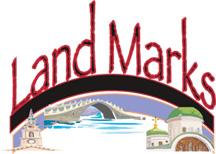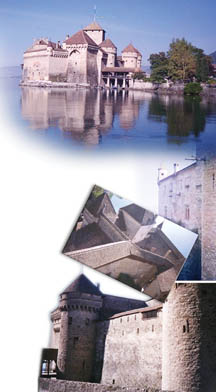
At the Chillon Castle
Little Blue Birdie's Diary
Dear Diary,
This week, we flew to the land of mountains and beautiful sceneries.
This is also the country which is famous for chocolates and
wrist-watches. Ah! Now you know the place. Of course it's Switzerland.
There are many castles and fortresses in European countries. We have
already visited many of them.
Today, we went to see another castle, one named Chillon Castle in
Veytaux, Switzerland. This castle is famous in the world of literature
as well, because the well-known poet, Lord Byron had described the place
like this:
Lake Leman lies by Chillon's walls:
A thousand feet in depth below
Its massy waters meet and flow...
There are seven pillars of Gothic mould,
In Chillon's dungeons deep and old,
There are seven columns massy and grey,
Dim with a dull imprisoned ray,
A sunbeam which hath lost its way?
Lord Byron wrote this for a prisoner, Francois Bonivard, who was a
lay official at St. Victor's Priory (monastery) in Geneva. He had spoken
out in favour of the Reformation, and was imprisoned in this castle for
years. This beautiful castle is among the best-preserved medieval
castles in Europe. Our first glimpse of the castle was an unforgettable
experience. It was an elegant, turreted (tower-like) structure extending
out into the water, framed by trees and stony mountains.

We could have spent even half a day just looking at it. The beauty of
the place stunned Maria the Cuckoo and Koshy the Hummingbird. Mandy was
taking photographs as if she couldn't stop clicking. It was a heavenly
scene.
The Chillon Castle was built on a rocky inlet near the eastern shore
of Lake Geneva. A castle built to protect one of the main roads to the
Great St. Bernard Pass to Italy had stood here as early as the ninth
century. But, the present castle was, for the most part, built by the
Counts of Savoy during the late 12th and 13th centuries. "During the
16th century, the castle was used as a state prison and was the setting
for the English poet Byron's The Prisoner of Chillon, which was written
in 1816", explained Aaron, the guide bird.
It was like stepping back in time, into the life of a
still-functioning castle. The castle was filled with furniture of that
era and had beautiful window seats where, I think, women may have sat
and embroidered clothes. The view from the highest tower was
spectacular; the dungeons were really dark; and we saw where Lord Byron
had scratched his name, in one of the pillars.
The castle consisted of 25 building units, all jammed together in a
classically crowded medieval style. This included the Grand Hall, the
Hall of Justice, the Armouries, the Grand Hall of the Count, the Duke's
Chamber and Saint George's Chapel. The oldest part of the building dates
back to the first millennium.
In the 13th century, under Count Peter II Savoy, Chillon had
completely transformed and considerably extended. Roman and early Gothic
architecture are characteristic. Today, the castle is carefully restored
and can be visited from the basement (jail) to the tower.
Special attention is given to the prison, where Bonivard was chained
to the pillar between 1530 and 1536. For the last 200 years, the castle
had been owned by the Canton of Vaud, and had been a tourist attraction,
since it was visited (and popularised) by 19th Century poets and authors
such as Byron, Shelley, Victor Hugo, Hans Christian Andersen, Flaubert,
Mark Twain and Charles Dickens.
My friends and I hope that all children as well as birds will have
the luck to visit this castle one day.
It's really amazing. After concluding our visit inside the castle,
Zorro and Buddy wanted to play cricket on its lawns. It was such fun.
See you soon with details of another wonderful place.
Bye! |


